Textüberschrift
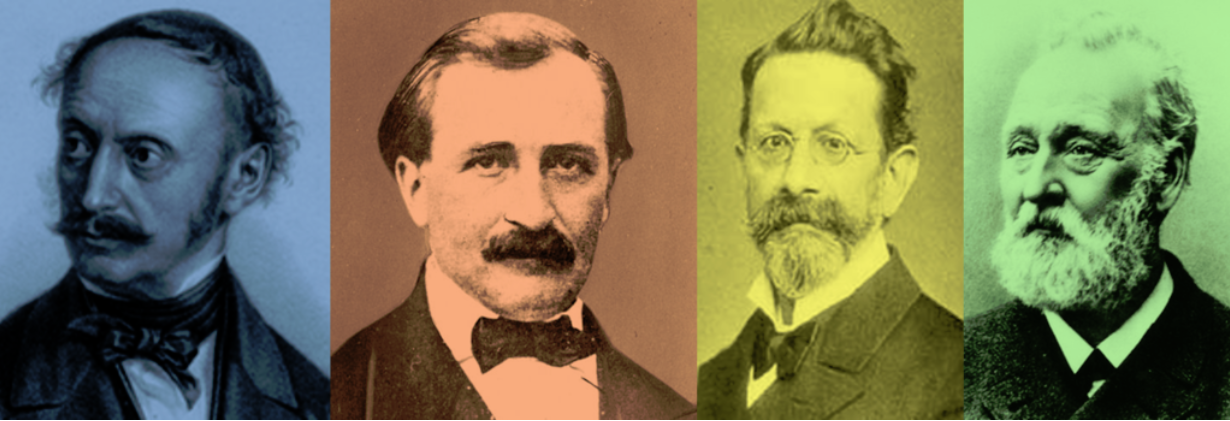
-
9.2 Der Bergkittel
-
10.1.1 Übersicht
-
10.1.4 Walchner's Bücher
-
10.1.5 Walchner und die Demokratie
-
10.1.6 Walchner, Rottek, Welcker
-
10.1.12 Walchner und seine Familie
-
10.2.1 Übersicht
-
10.3.1 Übersicht
-
10.4.1 Übersicht
-
10.4.3 Maria Gräfin von Linden 1890
-
10.5.1 Übersicht
-
10.6.1 Übersicht
-
10.7.1 Übersicht
-
10.7.2 Paulcke und der 1. Weltkrieg
-
10.7.4 Paulcke und der Alpinismus
-
10.7.8 Paulcke und seine Familie
-
10.7.10 Martin Henglein am KIT 1917-?
-
10.8.1 Übersicht
-
10.8.4 Studieren im 2. Weltkrieg
-
10.9.1 Übersicht
-
10.10.1 Übersicht
-
10.11.1 Übersicht
-
10.12.1 Übersicht
-
10.13.1 Übersicht
-
14.4 Reorganisation der Geowissenschaften in Baden-Württemberg
Textüberschrift
Einleitung
Das KIT ist eine der ältesten technischen Universitäten weltweit. Nach der von Nicolas Carnot und Gaspard Monte in Paris 1794 gegründeten Ecole Polytechnique und den polytechnischen Schulen in Prag (1806) und Wien (1815, umbenannt in Technische Universität im Jahr 1875), entwickelte man in Karlsruhe ein eigenständiges Konzept zur weiterführenden Ausbildung für Industrie und Verwaltung.
Seit der Gründung vor fast 200 Jahren sind die Angewandten Geowissenschaften integraler Bestandteil des KIT. Die globalen Herausforderungen erfordern mehr denn je eine exzellente Geo-Expertise zu den natürlichen Ressourcen, um der Gesellschaft nachhaltig Energie, Rohstoffe und Wasser zur Verfügung zu stellen. Entsprechend adressieren die Angewandten Geowissenschaften@KIT unter dem Slogan "Umwelt nachhaltig nutzen, auf und unter der Erde" die Themen GeoEnergie, Grundwasser, Rohstoffe und Speicher.
Die Gründung der Polytechnischen Schule Karlsruhe 1825
Die Badische Polytechnische Schule wurde am 7.10.1825 von Großherzog Ludwig I. von Baden (*1763 in Karlsruhe – †1830 ebenda) auf Anregungen von Gustav Friedrich Wucherer gegründet. Der evangelische Stadt- und Universitätspfarrer Freiburgs und Physiker Gustav Friedrich Wucherer (*1780 in Karlsruhe – †1844 in Freiburg) war 1813 bis 1823 ordentlicher Professor für Physik und Technologie in Freiburg. Er wurde 1821 als Nachfolger des 1821 verstorbenen Physiklehrers Karl Wilhelm Böckmann (*1773 in Karlsruhe – †1821 ebenda) aus Freiburg als Lehrer für Physik an das Lyceum und als Kustos des Physikalischen Kabinetts nach Karlsruhe berufen. Wucherer regte nach seinem Aufbau eines Polytechnischen Instituts in Freiburg „zur Bildung des Volkes in allen Ständen“ ein Ebensolches in Karlsruhe an und wurde von 1825 bis 1832 dessen erster Direktor.
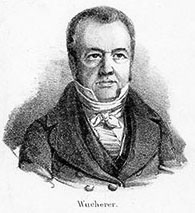
Abb. Gustav Friedrich Wucherer (Quelle)
Zuvor hatten schon der Beamte Johann Gottfried Tulla (*1770 in Karlsruhe – †1828 in Paris) und der Architekt Friedrich Weinbrenner (*1766 in Karlsruhe – †1826 ebenda) 1808 in der konstituierten Generalstudienkommission die Gründung einer polytechnischen Schule in Karlsruhe forciert. Der Ingenieur Tulla war vom Markgraf Karl Friedrich unter anderem 1794-1796 zum Studium der Chemie, Geologie und Mineralogie an die Bergakademie Freiberg und 1801 an die Ecole Polytechnique nach Paris geschickt worden, wo er Eindrücke einer angewandten Bildung gewann. Auch der badische Staatsrat Karl Friedrich Nebenius könnte solche Eindrücke bei seinem Aufenthalt 1809 in Paris gesammelt haben.
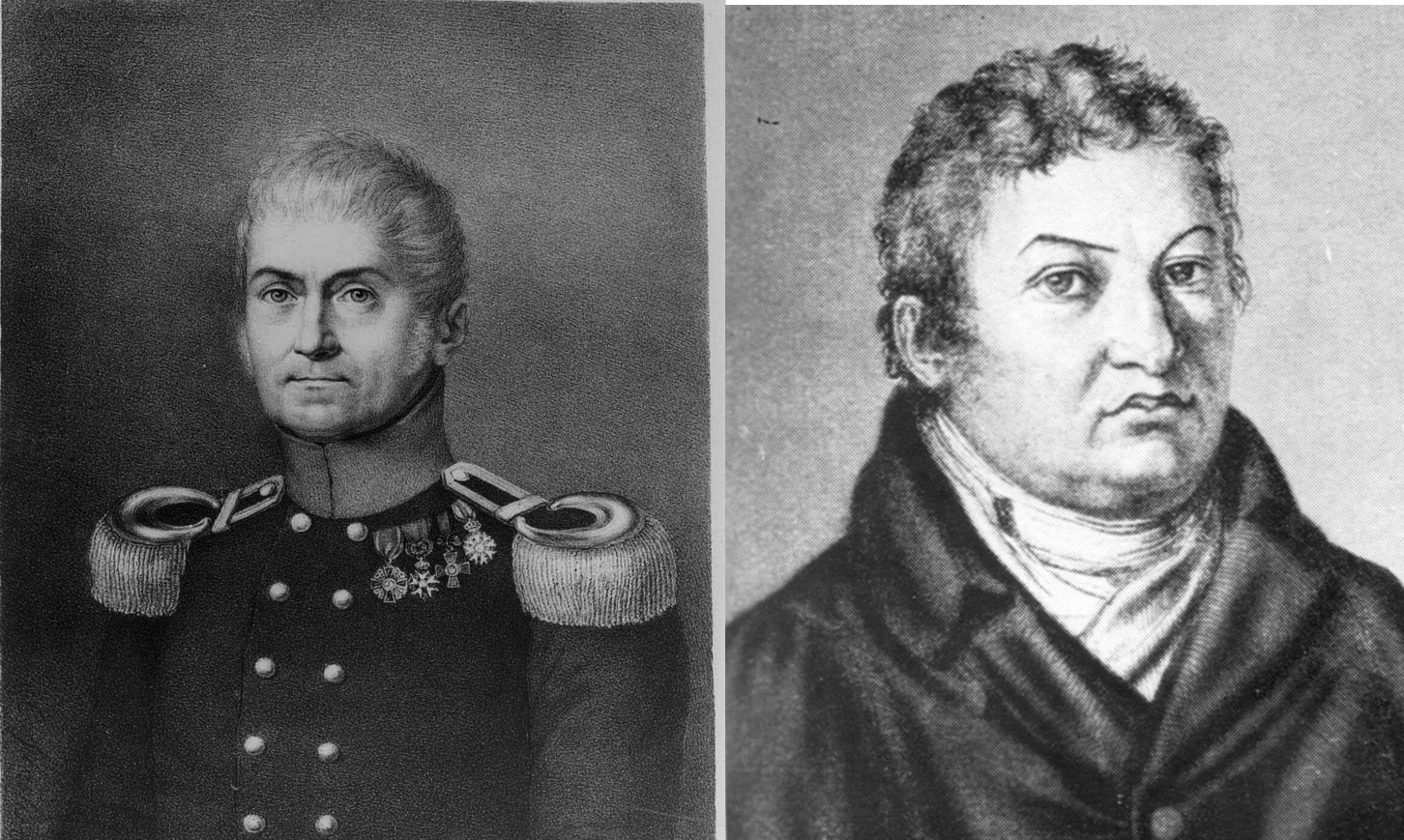
Abb. Tulla und Weinbrenner Quelle KIT-Archiv Tulla, Quelle KIT-Archiv Weinbrenner
In Karlsruhe existierten bereits
- das erstmalig 1752 erwähnte markgräfliche Naturalienkabinett, das von Markgräfin Caroline Luise von Hessen-Darmstadt (*1723 in Darmstadt – †1783 in Paris), der Ehefrau des Markgrafen Carl Friedrich aus Karlsruhe, gegründet wurde, "den schönsten und reichsten derartigen Anstalten in Deutschland" [34]
- seit 1768 (mit zeitweisen Schließungen) ein Architektonisches Institut für Bauhandwerker, welches der Baumeister Friedrich Weinbrenner 1796 als Architektenschule (eine öffentlich geförderte Privatschule, "Bauschule") etablierte
- die durch den Markgrafen Carl Friedrich 1774 eröffneten anwendungsbezogenen Schulklassen ("Realklassen") des Bismarck Gymnasiums (gegründet 1586 als Gymnasium illustre in Karlsruhe-Durlach und 1724 nach Karlsruhe Innenstadt verlagert), in denen der Schwerpunkt mehr auf Mathematik, Mechanik und Naturkunde gelegt wurde als in den gymnasialen Klassen.
- das 1778 gegründete markgräfliche physikalische Cabinet des Markgrafen Carl Friedrich
- die Ingenieurschule, die 1807 von Johann Gottfried Tulla gegründet wurde
Damit verfügte Karlsruhe über ausreichende Schnittstellen, um die gewünschte Industrialisierung mit einer polytechnischen Schule voranzutreiben.
Die Gedächtnisrede von Heinrich Schreiber 1844 auf Wucherer zeigt die Rolle Wucherer’s zur Gründung des KIT 1825:
„Durch Ministerial-Erlass vom 7. Mai 1824 wurde Wucherer aufgefordert, den Plan zur Errichtung einer solchen Anstalt (Anm. Errichtung einer polytechnischen Schule zu Karlsruhe) zu entwerfen und vorzulegen: „weil er bereits früher zur Gründung eines solchen Instituts in Freiburg, - wenn gleich, wie es der Lage der Dinge nach nicht anders seyn konnte, von mässigem Umfange, doch wohlthätig in seinen Wirkungen, - wesentlich beigetragen; derselbe also diesem Gegenstand schön längere Zeit reifliches Nachdenken gewidmet, auf Zeit und Gelegenheit gehabt hat, die Lehranstalten in Karlsruhe kennen zu lernen; also vor Allen berufen sein möchte, gutächtlich vorzuschlagen, wie eine solche Anstalt nach den Bedürfnissen des Grossherzogthums und nach dem Verhältnis seiner Mittel, zu Erhaltung des Gleichgewichts mit allen übrigen wesentlich nothwendigen Staatseinrichtungen, gegründet werden könne. Wucherer entsprach den Erwartungen so sehr, dass ihm, unter Beibehaltung seiner Lehrstelle am Lyceum, die Direction der am 1. Dezember 1825 eröffneten neuen Landesanstalt übertragen wurde. Auch die Professoren für die erste Besetzung wurden von ihm vorgeschlagen, mit denen er unverdrossen an einer grossartigen Einführung der mathematischen und naturhistorischen Wissenschaften in die Sphäre des praktischen Lebens arbeitete, in der sie seit zwanzig Jahren in Deutschland so gute Früchte getragen haben.“
Die 12 Gründungsväter des KITs im Jahr 1825 waren die beiden Professoren aus Freiburg Gustav Friedrich Wucherer für Physik (*1780 in Karlsruhe – †1844 in Freiburg, erster Direktor von 1825-1832), Friedrich August Walchner für Chemie, Geologie und Mineralogie (*1799 in Meersburg – †1865 in Karlsruhe, zweiter Direktor von 1832-1836), der promovierte Wilhelm Ludwig Volz für Mathematik und Maschinenbau (*1799 in Rastatt – †1855 in Tübingen, dritter Direktor von 1837-1840), während die weiteren Dozenten Gymnasiallehrer und Handwerker waren. Aus den Schulen Tulla‘s und Weinbrenner‘s wurden Lehrer an das Polytechnikum für grundlegende Lehrveranstaltungen des Lyceums gesandt, die weiterführende Lehre wurde in den eigenständigen Schulen durchgeführt. Beide Schulen blieben aber bis zu Neustrukturierung durch Nebenius 1832 eigenständig. Die polytechnische Schule war ab 1825 zunächst im neuen Südflügel des bereits überfüllten Lyceums untergebracht.
Die Probleme begannen schon mit der Gründung. Die Dozenten waren schlecht bezahlt und die Finanzierung der polytechnischen Schule reichte nicht, Apparate und Modelle für die Lehre anzuschaffen. Gleichzeit war das Schulgeld hoch, und der Lehrplan unorganisiert. Im viel gelesenen Polytechnischen Journal wurde 1825 im Artikel Einige Bemerkungen über das neue polytechnische Institut in Karlsruhe (Band 18, Seite 475-477) moniert:
„Durch die Fortschritte der mathematischen und Naturwissenschaften ist den Fortschritten in der Technik ein erfreulicher Weg geöffnet, und um ihn allgemein zugänglich zu machen, bedarf es der Errichtung von polytechnischen Schulen, wozu Frankreich das Muster gegeben hat. In Karlsruhe wird jetzt ein solches Institut gegründet; allein nach den darüber bekannt gewordenen Planen und Anordnungen scheint man dort den Begriff einer polytechnischen Schule anders aufgefaßt zu haben. Die Basis solcher Institute ist angewandte Mathematik, und wie verschieden auch die künftigen bürgerlichen Bestimmungen der einzelnen Schüler seyn mögen, so ist ihre Bahn doch im Anfange eine und dieselbe, denn der Tischler, der Schlosser, der Zimmermann, der Mechanikus, der Ingenieur, der Fabrikant etc. bedürfen gemeinsamer Elementarkenntnisse und Einübungen, und sie trennen sich erst da, wo nun jeder gehörig ausgerüstet ist, seinen besondern Weg einzuschlagen, und das Erlernte in einem bestimmten Gewerbe oder in einer bestimmten Kunst in Anwendung zu bringen. Aus einer wohlgeordneten polytechnischen Schule kann sich nicht jeder seine beliebige Portion nach Lust und Laune herausnehmen, wie an der Tafel des Restaurateurs; sie ist ein genau verbundenes organisches Ganzes, und wie in jeglichem naturgemäßen Entwikelungsgange, so darf auch hier kein Ast und Zweig sich in der Luft bilden wollen; er muß vom gemeinsamen Stamme ausgehen, wie dieser von der gemeinsamen Wurzel. … Dieses Auskunftmittels bedürfte es nicht, wenn die Anstalt die gehörige Basis hätte, und nicht ein Haupttheil des Materials derselben zur Verzierung des Gebäudes verwendet worden wäre. Wer das polytechnische Institut in Paris kennt, der weiß auch, wie konsequent dort die Aufgabe gelöst, und die Form aus dem Zweke abgeleitet worden. Daher die große Simplicität und der streng geregelte Gang in der ganzen Einrichtung. In der That handelt es sich hier nicht von der reinen Wissenschaft, sondern von der Anwendung derselben auf die Produktionen der verschiedenen Künstler und Gewerbsleute, …. Die Weltgeschichte ist in die Vorbereitungsklasse gewiesen. Aber Jünglingen von 13 bis 14 Jahren kann man keine Weltgeschichte vortragen. …. Wenn ein polytechnisches Institut die gemeinnüzigen Folgen haben soll, welche man den Absichten der Gründe nothwendig unterlegen muß, so ist, außer der zwekmäßigen Einrichtung auch noch erforderlich, daß es allgemein zugänglich sey, und kein Talent ausschließe. Das Honorar der Karlsruher Schule ist, für die Vorbereitungsklasse auf 16 fl. für die übrigen Klassen auf 44 fl. jährlich bestimmt, ohne die Einschreibegebühren. Wer nur eine Lektion besucht, zahlt 11 fl. u.s.w. Bücher, Zeichnungs-Materialien etc. kosten gleichfalls Geld. Von einer Befreiung der Unvermögenden ist keine Rede. Polytechnische Institute sind aber hauptsächlich für die Söhne der Bürgerklasse bestimmt, und diese ist in Deutschland eben nicht mehr als die wohlhabende zu betrachten. Es wäre in der That zu wünschen, dergleichen Anstalten würden den Lehrlingen so wenig als möglich erschwert. Dieß liegt auch gewiß nicht im Sinne einer Regierung, welche so willig das Talent ermuntert, das Verdienst belohnt und alles Nützliche, Gute und Schöne fördert. Vielleicht fehlt es dem beginnenden Institute noch an Fonds? In dem Falle wünschen wir von Herzen, daß reiche, hochherzige Patrioten ins Mittel treten möchten.“
Die Reorganisation des Polytechnikums Karlsruhe 1832
Der badische, liberale Staatsrat und Freimaurer Carl Friedrich Nebenius (*1784 in Rohdt – †1865 in Karlsruhe) wurde 1830 Staatsrat und Ministerialdirektor unter Innenminister Winter, einem Freund von Großherzog Leopold. 1831 wurde ihm das wichtige Respiciat für die Universitäten und höheren Lehranstalten übertragen. 1832 strukturierte er die polytechnische Schule zur Unterstützung der Industrialisierung neu, die er als „eine wahre Mißgeburt“ vorgefunden habe. Nebenius schloss die Ingenieurschule des verstorbenen Tullas, die Architektenschule des verstorbenen Weinbrenners und die staatliche Forstschule der polytechnischen Schule vollständig an. Neben einem Grundstudium wurden fünf Fachschulen aufgebaut, eine Struktur die weder die Ecole Polytechnique noch das bis dahin führende Wiener Polytechnikum aufweisen konnte. Nach jahrelangen Disputen mit der Staatsbehörde beendete Wucherer durch einen Stellentausch mit Seeber aus Freiburg 1834 seine Tätigkeit in Karlsruhe und kehrte an die Universität Freiburg zurück.
Der Geologe Friedrich August Walchner wurde von 1832 bis 1836 zum zweiten Direktor der polytechnischen Schule ernannt. In dieser Zeit konnte die polytechnische Schule das Lyceum verlassen und der Neubau in der Kaiserstrasse 12 bezogen werden.
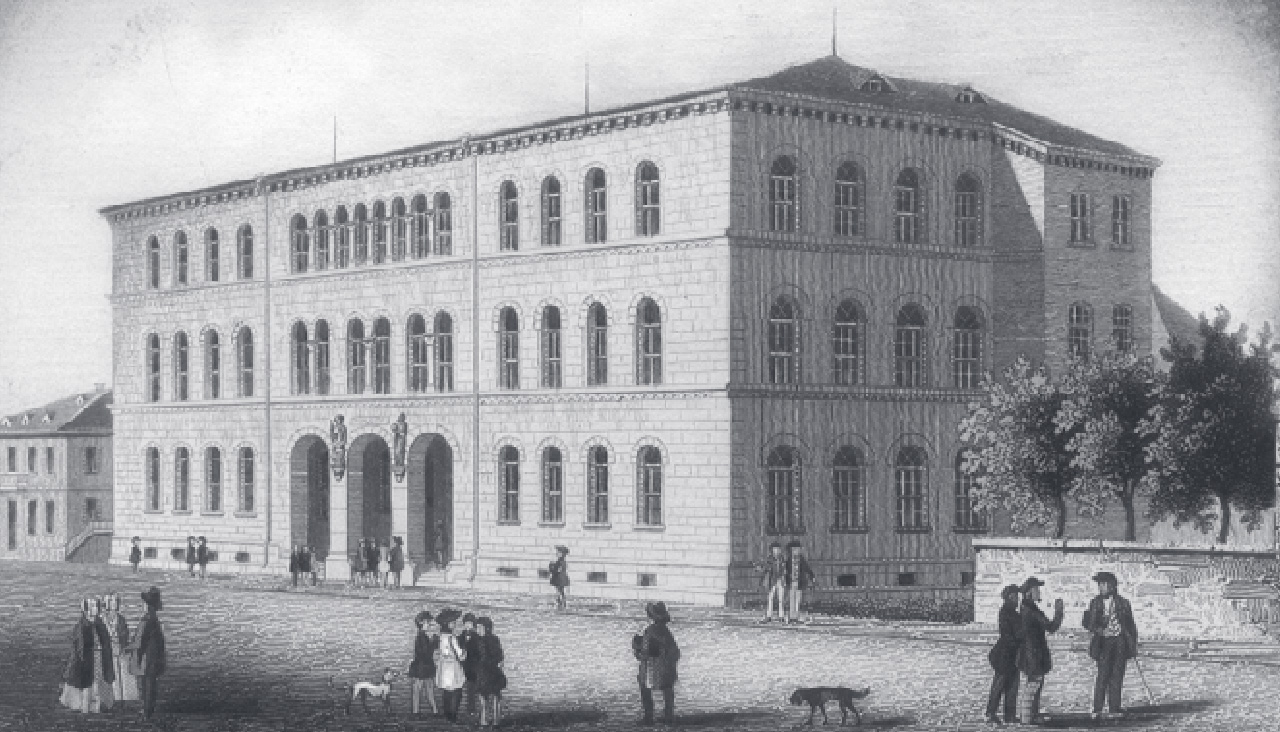
Abb. Der Neubau der Polytechnischen Schule 1836 Quelle Hopke 2000 S. 38
Walchner stand auch der Fachschule Höhere Gewerbeschule für Chemiker, Gärungsgewebe, für Berg- und Hüttenwesen, einer der fünf Fachschulen der polytechnischen Schule, vor. Darin war auch der Maschinenbau mit Wilhelm Ludwig Volz angesiedelt. Neben den Klassen für die mathematische Grundausbildung gab es fünf Fachschulen:
- Ingenieurschule
- Bauschule
- Forstschule
- Höhere Gewerbeschule für Chemiker, Gärungsgewerbe, für Berg- und Hüttenwesen
- Handelsschule.
Die Anzahl der Lehrer wurde auf über 30 und der Zugang der Schüler zur Fachschule von 15 auf 17 Jahre erhöht. Nebenius´ Reform führte zu einer besseren Dotierung der Dozenten und einer besseren Organisation, aber trotz Reform hatte die polytechnische Schule keinen Haushalt und musste jedwede Anschaffung beim Innenministerium anfragen. Das Kollegium wurde nach wie vor schlecht bezahlt, und selbst 1840 wurde in den Berufungsschreiben des Innenministeriums keine Zusicherung des Nominalfachs zugesichert, „weil es in der polytechnischen Schule nicht üblich ist und weil die Regierung den Grundsatz nicht aufgeben kann, ihre Staatsdiener nach eigenem Ermessen zu verwenden“ [4].
Carl Friedrich Nebenius hatte die 1818 in Kraft getretene badische Verfassung mit Karl von Rotteck mit einem Zweikammerparlament geschrieben. Darin war der Schutz des Eigentums und persönlicher Freiheiten, die Religionsfreiheit, ein Wahlrecht und die unabhängige Gerichtsbarkeit festgeschrieben. Grund für die Verfassungen waren die aufkommenden Unruhen: Durch den Ausbruch des indonesischen Vulkans Tambora im April 1815 kam es 1816 in Europa zum Jahr ohne Sommer und 1817 zum Jahr der Bettler mit großen Hungersnöten. Der Weizen kostete 240% mehr, in Baden starben mehr Menschen als geboren wurden. Etwa 20% der Einwohner des Großherzogtums Baden, etwa 18.000 Einwohner, wanderten aus Not nach Amerika und Russland aus. Ein Zeitzeuge berichtet: „Am Neujahrstag war es heiß wie im Sommer. Im Mai war es kalt wie sonst im Februar. Die Brunnen sind zugefroren, dass man kein Wasser holen konnte. Im Juni setzte dann ein Regen ein, der nicht enden wollte. Auf den Feldern verfaulte das Korn. Im Juli vernichtete ein Hagel alles, was gewachsen war“ [14]. Nebenius sah in der technischen Entwicklung und Innovation die Lösung des Problems der Überbevölkerung des Großherzogtums Baden - die Bevölkerung Karlsruhes stieg von 10.597 1810 auf 23.484 1840, heute 313.092 Einwohner – Herr zu werden und schrieb, dass „allein ein geschickterer Gebrauch der Hilfsmittel der Produktion imstande sei, die unabsehbaren Folgen der Überbevölkerung Badens abzuwenden“ (aus [29]: S. 34-35).
Auch für einen staatlich finanzierten Bau der Eisenbahn zwischen Mannheim und Basel zeigte sich 1836 Nebenius verantwortlich. 1840 wurde die Strecke Mannheim-Heidelberg, und 1855 bis Basel eröffnet. 1870 wurde die direkte Strecke Mannheim-Graben-Neudorf-Eggstein-Karlsruhe fertiggestellt.
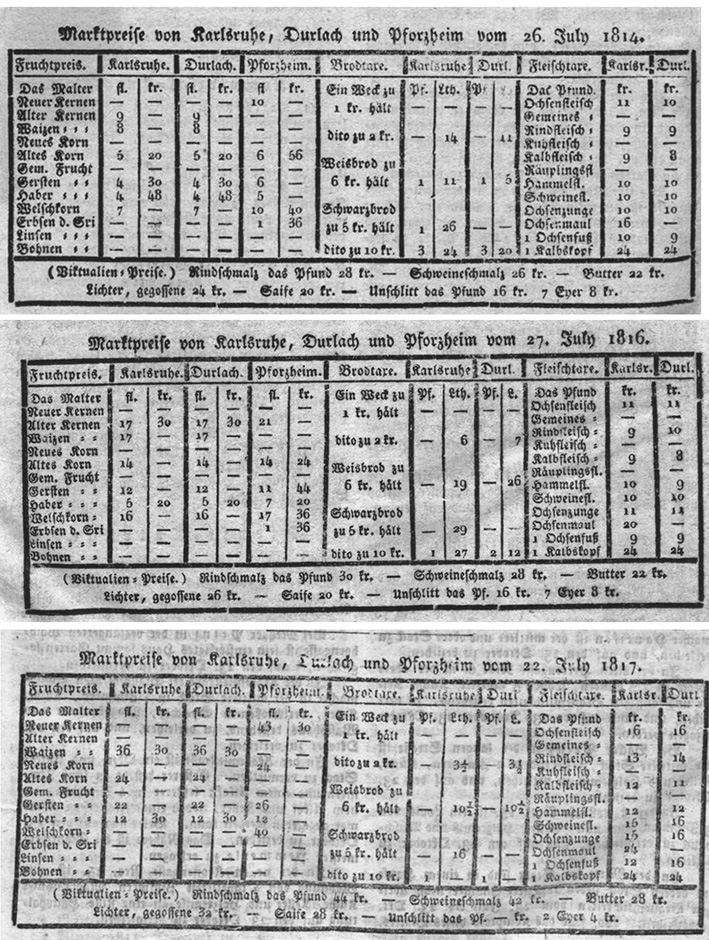
Abb. Marktpreise vom 30.7.1814 Quelle, 27.7.1816 Quelle Karlsruher Intelligenz- und Wochenblatt vom Mittwoch 31. Juli 1816 und 23.7.1817 Quelle
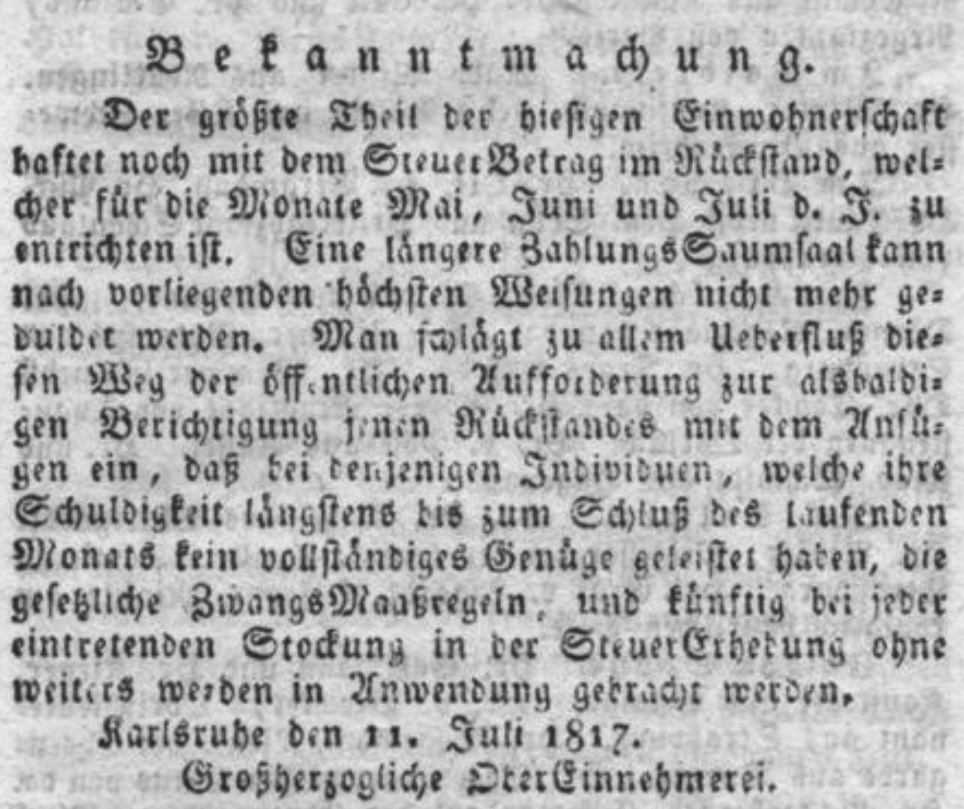
Abb. Trotz Hungersnot werden in Baden Steuern eingetrieben, die Menschen verarmen Quelle Karlsruher Intelligenz- und Wochenblatt vom Mittwoch 23. Juli 1817
Carl Friedrich Nebenius stieg unter Großherzog Leopold 1830 im Staatsapparat bis 1838 zum Innenminister auf, wurde aber durch Intrige von Außenminister Friedrich Landolin Freiherr von Blittersdorf, einem Gegner der Badischen Verfassung, gestürzt. 1843 war von Blittersdorf gescheitert und Nebenius vom Großherzog Leopold 1843 in die Erste Kammer berufen worden. Nach kurzer Leitung des Innenministeriums vom 28.3.1845 bis Dezember 1846, die er nur unter der Bedingung annahm, alsbald einen geeigneten Nachfolger zu finden, wurde er im Rahmen der Niederschlagung der Revolution am 3.6.1849 wie alle seine Freunde seines Amtes enthoben und am 1.7.1849 pensioniert.
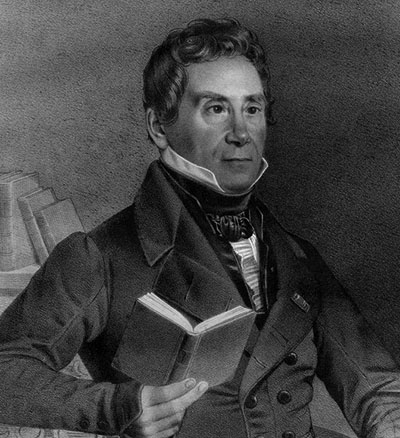
Abb. Karl Friedrich Nebenius (Quelle).
Die weitere Entwicklung des Polytechnikums Karlsruhe
Der 1841 berufene Professor für Mechanik und Maschinenlehre Ferdinand Redtenbacher (*1805 in Steyr – †1863 in Karlsruhe) initiierte 1847 mit Unterstützung des Innenministeriums die Teilung der Höheren Gewerbeschule (Fachschule) in eine chemisch-technische (ab 1860 Chemische Schule) und eine mechanisch-technische Fachschule (ab 1860 Maschinenbauschule). Redtenbach folgte auf Wilhelm Ludwig Volz (*1799 in Rastatt – †1855 in Tübingen), der nach seinem Direktorat des Polytechnikums Karlsruhe von 1837 bis 1840 ab 1841 bis 1855 ordentlicher Professor für Technologie in Tübingen und dort 1848/1849 Rektor war. Redtenbach leitete das Polytechnikum als dessen siebter Direktor von 1857 bis 1862. In Deutschland gilt Redtenbacher als Begründer des wissenschaftlichen Maschinenbaus. In einem Brief schrieb er an einen Freund: „Ich hoffe, den Leuten noch den Beweis unter die Nase zu halten, dass die Mathematik kein Luxus ist, und dass man mit derselben in dem Maschinenbau etwas leisten kann, vorausgesetzt, dass man vom Praktischen etwas versteht und genau weiß, was für's Leben notwendig ist". Einer seiner Schüler war Carl Benz (*1844 Mühlburg - †1929 Landburg), der Erfinder des Automobils.
Redtenbacher‘s Nachfolger Franz Grashof (*1826 in Düsseldorf – †1893 in Karlsruhe), 1863 bis 1891 Professor für Theoretische Maschinenlehre, erreichte, dass das Polytechnikum Karlsruhe von Großherzog Friedrich I. von Baden 1865 als Technische Hochschule Hochschulrang erhielt. Dies beinhaltete eine gewisse Selbstverwaltung und Lehrfreiheit, sowie den Abschluss mit einem Diplom seit 1867, das Habilitationsrecht seit 1868 und das Promotionsrecht seit 1899. Allerdings wurde der Name Technische Hochschule erst 1885 eingeführt. Seit 1902 wurde die Technische Hochschule Karlsruhe zu Ehren von Großherzog Friedrich I. auch Fridericiana genannt.
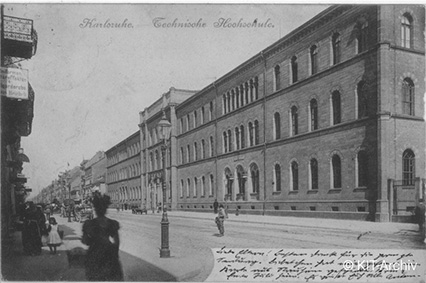
Abb. Die TH Karlsruhe etwa 1890 Quelle KIT-Archiv
Zeitgleich mit Redtenbacher begann Karl Weltzien (*1813 in Sankt Petersburg – †1870 in Karlsruhe) 1841 seine Lehrtätigkeit am Lyceum und am Polytechnikum Karlsruhe. 1850 wurde er zum ordentlichen Professor ernannt und es wurde ihm bis 1851 ein chemisches Institut gebaut. Weltzien gilt als Begründer der wissenschaftlichen Chemie. Er richtete 1860 den ersten internationalen Chemikerkongress in Karlsruhe aus. Walchner wurde 1850 gegen seinen Willen als Vorstand der Chemisch-Technischen Schule abgelöst. Ob dies ausschließlich auf den schwindenden Zuspruch von Studierenden - Walchner sah die Chemie eher im technischen Bereich der Aufbereitung- oder auch Walchners politischem Engagement geschuldet ist, sollte eruiert werden.
Das Polytechnikum Karlsruhe wurde zu einem Vorbild für andere polytechnische Schulen wie die ETH Zürich (gegründet 1855, umbenannt in ETH 1911), TU Darmstadt (gegründet 1836), TU Dresden (gegründet 1828, umbenannt 1890), TU Braunschweig (polytechnische Schule gegründet 1862), TU München (gegründet 1827) und RWTH Aachen (gegründet 1870). Die Polytechnische Schule (heute KIT) bot Studiengänge für Architekten, Bauingenieure, Maschinenbauingenieure und Chemiker an, auch die Geowissenschaften (damals Geognosie genannt) waren von Anfang an mit dabei. Seit 1847 agierte die Polytechnische Schule eigenständig. Der Gründungsdirektor des MIT bemerkte bei seinem Besuch in Karlsruhe 1864, dass das Carlsruhe Institute besser als jede andere Institution dem entspreche, was als Massachusetts Institute of Technology geplant sei.
Geologie am KIT seit 1825
Die Geologie war 1825 in der Höheren Gewerbeschule angesiedelt. Von 1948 bis 1969 war die Geologie Teil der Abteilung Chemie in der Fakultät für Natur- und Geisteswissenschaften. Im Jahr 1969 wurde eine Fakultät in Mathematik und Naturwissenschaften und eine Fakultät für Bio- und Geowissenschaften eingerichtet. Seit 2002 sind die Angewandten Geowissenschaften Teil der Fakultät für Bauingenieurwesen, Geo- und Umweltwissenschaften. Die Geophysik am KIT wurde 1964 etabliert und ist seitdem Teil der Fakultät für Physik.
2009 wurden die TH Karlsruhe und das Helmholtz Forschungszentrum (Forschungszentrum Karlsruhe, gegründet 1956) zum Karlsruhe Institut für Technologie KIT mit einem durch das Land finanzierten universitären Bereich und einen durch den Bund finanzierten Großforschungsbereich zusammengeführt. 2021 konnten dann die unterschiedlichen Bereiche mit Landes- und Bundesmitteln über das Land Baden-Württemberg zusammengeführt werden. Die Geowissenschaften sind seit der Gründung 1825 Teil des KIT.
Die geschichtliche Entwicklung der Geologie seit 1345
Geologie ist die Wissenschaft (logos) der Erde (geo). Die Naturwissenschaft Geologie beschäftigt ich mit der Entwicklung der festen Erde, der Biosphäre und der Atmosphäre. Sie entwickelte sich mit der Suche nach Erzen und der Gewinnung von Metallen und ist eng mit dem Bergbau und der Metallurgie verknüpft. Der Bergbau auf Feuersteine begann im Jungpaläolithikum vor etwa 30.000 v.Chr. in Ägypten, in Deutschland seit 5000 v.Chr.. Der Kupferbergbau läutete das Ende der Steinzeit und den Beginn der Bronzezeit vor etwa 2200 v.Chr. ein. Das Wort Geologie findet sich bereits im Mittelalter in dem Buch Philobiblon (dtsch. Über die Liebe zu den Büchern, engl. Übersetzung A und B) des englischen Bischofs Richard de Bury (1281-1345), die er 1345 vollendete. Darin ist in Cap. IX zu lesen: "... Ex quibus liquido satis constat, quod sicut leges nec artes sunt nee scientiae, sic nec libri legum libri scientiarum vel artium proprie dici possunt; nec est haec facultas inter scientias recensenda, quam licet geologiam appropriato vocabulo nominare. Libri vero liberalium litterarum tarn/tam utiles sunt scripturae divinae, quod sine ipsorum subsidio
frustra ad ipsius notitiam intellectus aspiret." ["... Daraus geht ganz klar hervor, dass ebenso wie Gesetze weder Künste noch Wissenschaft sind, auch die Gesetzesbücher nicht richtig die Bücher der Wissenschaft oder der Künste genannt werden können. Es gibt keine Möglichkeit solche Wissenschaften zu überprüfen, was man als Geologie (die irdische Ordnung) mit einem passenden Namen benennen kann. Die Bücher der liberalen Künste sind so nützlich für die göttlichen Schriften, sodass ohne ihre Hilfe der Intellekt vergeblich danach strebt, sie zu verstehen."] Somit wurde im Mittelalter vermutlich von de Bury in Durham, England, das Wort Geologie erschaffen, was als Geologia / Erdwissenschaften das Gesetz oder Studium der Gesetze dem der irdischen Ordnung der Theologia (der göttlichen Ordnung) gegenüberstellte [15 in 32, 55]. Die Philobiblon wurde dann erstmals 1473 im Buchdruck in Köln, 1483 in Speyer und 1500 in Paris verlegt.
Georgius Agricola (Georg Bauer, 1494-1555) gilt als Gründervater der modernen Bergbaukunde und neuzeitlichen Geologie. In mehreren seiner Bücher wie De ortu et causis subterraneorum (1544), De natura fossilum (1546) und De re metallica (1556) beschäftigt er sich mit dem geologischen Untergrund, den Mineralen, der Lagerstättenbildung, dem Bergbau und der Verhüttung. Statt göttlicher Schöpfung erklärt er die Bildung der Minerale durch "versteindernde Fluide".
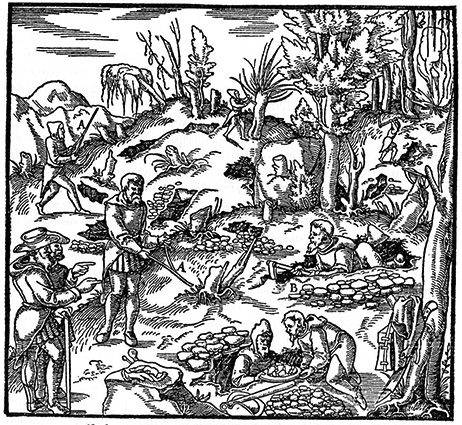
Abb. Skizze von Agricola zum Auffinden von Gängen mit Wünschelrute (A) und Schürfe (B). Quelle De Re Metallica Libri XXII von 1566, 2. Buch, Übersetzung vom VDI-Verlag 1978, S.32, s. auch Quelle B
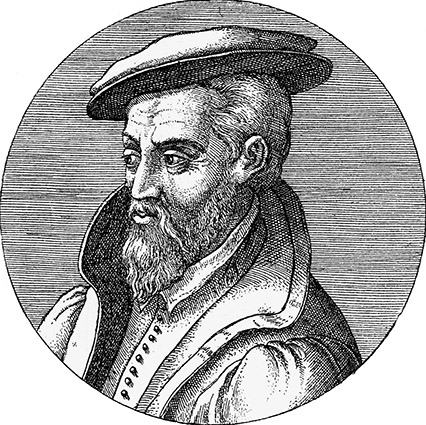
Abb. Gregorius Agricola auf dem Cover von De Re Metallica Libri XXII von 1566, 2. Buch, Übersetzung vom VDI-Verlag 1978.
Im 17. Jh. begann man, die Entwicklung des Lebens mit Fossilien einer ehemaligen Lebewelt, und die Landschaftsbildung mit naturwissenschaftlichen Prozessen zu assoziieren. Der einflussreiche Freiberger Geologe Abraham Gottlob Werner (1749-1817) führte neben seinen Vorlesungen zur Bergbaukunde 1780 die Gebirgskunde ein, die er 1783 Geognosie nannte. Der wenig gereiste Werner propagierte den (falschen!) Neptunismus, nach dem alle Gesteine (die alten plutonischen, darüber magmatischen, metamorphen und sedimentären Gesteine) aus dem Meerwasser während der Sintflut ausgefällt worden seinen.
Dem standen der schottische Geologe James Hutton (1726-1797) und englische Geologen wie Charles Lyell (1797-1875) gegenüber, die den (richtigen!) Aktualismus nachwiesen, nachdem sich die Gesteine entsprechend heutiger Prozesse ableiten lassen. Der Heidelberger Professor Karl Cäsar von Leonhard (1779-1862) und sein Sohn Professor Gustav von Leonhard (1816-1878) differenzieren in ihren Büchern (1835, 1841) Geologie und Geognosie. Sie bezeichnen die Geologie (damals auch Geogenie genannt) als Wissenschaft, die die Entstehungsweise der Erde ermittelt, und Geognosie als die Wissenschaft, die den gegenwärtigen Zustand der festen Erde erforscht. Daneben entwickelte sich die Oryktognosie (Mineralkunde, Mineralogie) und die Oriktognosie (Erkennungslehre der Fossilien, Paläontologie).
Geologie & Bergbau in Baden & Württemberg ab dem 17. Jh.
Salzbergbau in Baden und Württemberg: Vorkommen von Salz in Baden und Württemberg sind durch Flurnamen wie Saalbach (früher Salzbach genannt), Salzach u.a., und durch historische Quellen aus dem Mittelalter belegt. So wurde bspw. aus der bereits im Mittelalter versiegten Saline beim Weiler Salzhofen, der bis 1483 urkundlich belegt und heute Teil der Stadt Bretten ist, Salz gewonnen (Carle 1963 [13]. Auch auch Bruchsal und seit 1615 bis heute artesisch fördernde Quelle bei Ubstadt zeugen von Salzvorkommen im Untergrund. Daher wurde in Baden und Württemberg wurde die Suche nach Rohstoffen wie Salz forciert und1806 der international bekannte Professor Karl Christian von Langsdorf (1757-1834, Buch Neue Salzwerkkunde 1824) aus Wilna nach Heidelberg berufen. Zuvor war Langsdorf von 1784-1789 Ansbacher Salineninspektor in Gerabronn in Franken und dort von 1792-1794 Lehrer von Johann Gottfried Tulla. Langsdorf gilt als Initiator der erfolgreichen Bohrkampagnen von 1812 bis 1824 bei Offenau (1816), Wimpfen (1818), Dürrenheim (1822), Rappenau (1823) u.a. in Baden und Württemberg, allerdings blieb sein Erfolg auf Württemberg beschränkt. Langsdorf hatte in Regierungskreisen und der Universität Heidelberg viele Neider, die seine praktischen Tätigkeiten einschränkten. So wurde er von seinen Forschungen in Baden nach Salzvorkommen an die Universität zurückbeordert und er bemängelte "An akademischen Lehrern war seit Jahrhunderten kein Mangel, wohl aber fehlte es immer und fehlt es noch an Salinisten" [13]. In Jagstfeld, heute Teil von Bad Friedrichshall, wurde im April 1816 in erstmals erfolgreich Steinsalz in 150 m Teufe erbohrt und im Januar 1818 das mit Bohrloch-Sole betriebene Siedewerk in Betrieb genommen. 1820 nannte der württembergische König Wilhelm die Saline im Andenken an seinen Vater Friedrichshall. Ob die Schwierigkeiten einer praxisbezogenen Forschung an der Universität Heidelberg ein Grund für die Gründung des Karlsruher Polytechnikums gewesen sein könnten, bleibt zu eruieren.
(wie Bretten, Bruchsal, Königsbach u.a.).
Weiterer Bergbau und Bergamt: Zahlreiche Lagerstätten wurden und werden (kursiv) in Baden und Württemberg abgebaut. Dazu gehörten Explorationstätigkeiten, die von der markgräflichen und später großherzoglichen Bergbaubehörde in Karlsruhe begleitet wurden.
Tab. Gewinnung von Lagerstätten in Baden mit Beispielen von Gruben [71]. kursiv - in Betrieb.
| Eisen- und Manganerze (Neuenbürg, Freudenstadt u.a.) | Uranerz (Baden-Baden u.a.) | Steinsalz (Heilbronn, Dürrheim u.a.) |
| Silber- und Bleivererzungen (Christophstal bei Freudenstadt u.a.) | Rheingold (Rheinhausen u.a.) | Kalisalz (Buggingen) |
| Silber- und Kobaltvererzungen (Heubachtal Grube Anton) | Fluß- und Schwerspat (Wolfach, Käfersteige b. Pforzheim) | Gips und Anhydrit |
| Blei- und Zinkvererzungen (Grube Schauinsland) | Weißerdegruben für Porzellan (Malsch u.a.) | Steinkohle (Diersbach u.a.) |
| Nickelerz (Horbach Grube Friedrich-August) | Ton für Keramik und Ziegel (Rettigheim, Malsch u.a.) | Erdöl (Landau, Weingarten u.a.) |
| Kupfererzbergbau (Neubulach u.a.) | Sand für Glashütten (Altglashütte, Glaswald/Alpirsbach) | Kalksteine (Wössingen, Knittlingen u.a.) |
| Steine und Erden |
Da der Bergbau im Großherzogtum Baden eine größere und ältere Tradition als in Württemberg hatte, erließ der badische Kurfürst Carl Friedrich bereits 1803 ein Organisationsedikt für das Berg- und Salzwesen [Häußermann 1997, Ref 31]. Es wird von einer Bergwerkskommission in Freiburg ab 1822 und ab 1825 in der Stephanienstr. 26 in Karlsruhe einer dem Finanzministerium unterstellten Direktion der Salinen-, Berg- und Hüttenwerke [71] berichtet. Die Direktion unterstand ab 1833 den Bergrath Münzing [Adressbuch Haupt- und Residenzstadt Karlsruhe 1832]. Die Bergwerke und Hütten wurden 1832 in eine Direktion der Forsten und Bergwerke in Karlsruhe übertragen, und ab 1890 in Karlsruhe in eine Forst- und Domänendirektion als oberste Bergbehörde Badens überführt [31, Adressbuch Haupt- und Residenzstadt Karlsruhe 1832, 1833]. Als untere Behörde wird ein Bergmeister in Karlsruhe und zeitweise in Dürrheim eingerichtet, das 1922 in die Bezeichnung Bergamt umbenannt wurde. 1943 wurden die Zuständigkeiten im neu geschaffenen Reichsoberbergamt Karlsruhe mit den nachgeordneten Reichsbergämtern Karlsruhe (zuständig für Baden), Mühlhausen im Elsaß und Stuttgart (für Württemberg und Hohenzollern) erweitert. Nach dem zweiten Weltkrieg wurde 1945 im amerikanisch besetzen Teil ein Bergamt in Heilbronn und im französisch besetzten Teil ein Bergamt in Freiburg errichtet. Mit der Gründung des Landes Baden-Württemberg 1952 wurde ein Oberbergamt in Freiburg mit nachgeordneten Bergämtern in Karlsruhe (aufgelöst 1954), Freiburg und Heilbronn (aufgelöst 1968) errichtet. Das Bergamt Freiburg wurde 1973 zum Landesbergamt Baden-Württemberg ernannt [31].
Die Großherzoglich-Badische Geologische Landesanstalt wurde 1888 in Heidelberg gegründet. Der Heidelberger Geologe Professor Karl Heinrich Ferdinand Rosenbusch (*1836 Einbeck - †1914 Heidelberg) wurde 1888 dessen erster Direktor, und war 1871 Gründungsmitglied des Oberrheinischen Geologischen Vereins OGV. Dem voraus ging die geologische Landesaufnahme im Maßtab 1:50.000, die vom Karlsruher Professor Carl Ludwig Fridolin Sandberger 1856 durchgeführt wurde. 1907 wurde die Großherzoglich-Badische Geologische Landesanstalt nach Karlsruhe, und 1910 nach Freiburg übersiedelt. Im Jahr 1998 wurden das Geologische Landesamt und das Landesbergamt zum Landesamt für Geologie, Rohstoffe und Bergbau LGBR des Landes Baden-Württemberg zusammengeschlossen.
Badischer Bergwerksverein: Zur Wiederentwicklung des Schwarzwälder Bergbaus wurde 1826 der Kinzigthaler Bergwerksverein mit Sitz in Karlsruhe gegründet. Dieser ging 1835 durch Zusammenschluss mit anderen Gruben in den Badischen Bergwerksverein (auch Badischer Generalbergwerkverein) mit Sitz in Karlsruhe, Langestrasse 141, über [63]. Es wurden "dazu 2000 Aktien zu 200 fl., und von 4600 Aktien zu 1000 fl. ein Kapital von Millionen zusammengebracht" [63]. Zu den Aktionären des Badischen Bergwerksvereins gehörten der Bankier Louis von Haber, Professor August Walchner, Sekretär Hartmann, Rupprecht, Domänenräte Abbeck und Eberlein, Major Kunz, Oberrevisor Klausing und Dr. Weindel [29]. Es wurden Gruben im Münstertal und vier Gruben im Kinzigtal aufgenommen [29]. Allerdings produzierte die Grube St. Anton im Heubachtal von 1834 bis 1850 etwa 750 kg Silber und 190 kg Kobalterz [30, 57]. Aus dem Kobalterz wurden im Blaufarbenwerk Kobaltoxide hergestellt, die als Blaupigmente Verwendung fanden. Da das Großherzogtum das Kapital für einen notwendigen tieferen Bergbau ab den 1840er Jahren nicht mehr aufbringen konnte, gründete man 1847 den Badisch-Englischen Bergwerksverein / Kinzigthal Mining Association (auch Kinzigthaler Bergbauverein, Kinzigthaler Bergbaugesellschaft genannt) mit Sitz und Karlsruhe und London. Durch das eingeworbene Aktienkapital konnte der Ausbau zunächst vorangetrieben werden, stellte aber den Betrieb dann im Kinzigtal 1857 ein und verkaufte 1859 die Bergwerke an eine französische Gesellschaft [29]. 1864 stellte dann auch der Badische Bergwerkverein seine Aktivitäten im Kinzigtal ein.
Black Forest Observatory: Seit 1972 wird die Grube St. Anton als geowissenschaftliches Observatorium Wolfach (Black Forest Observatory) bei Schiltach durch das KIT und die Universität Stuttgart betrieben. Es wird berichtet, dass das Bergwerk neben dem Kobalterz Silbernester in Baryt führte.
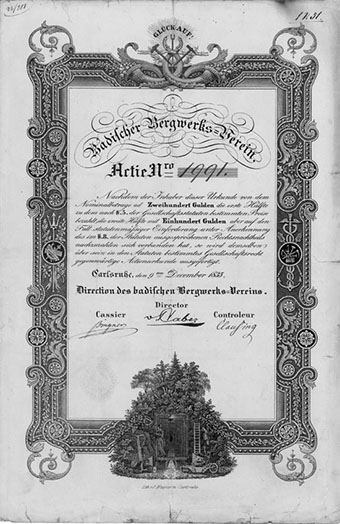
Abb. Aktie des Badischen Bergwerksvereins von 1835 (Quelle: Historisches Wertpapierhaus AG, Zorneding, Los 668).
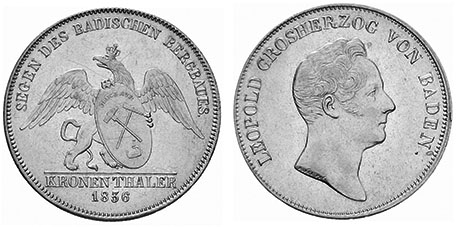
Abb. Kronenthaler "Segen des Badischen Bergbaus".
Bedeutende Geologen Badens
Oberbergrat Carl Friedrich Erhard, Oberbergrat Karl Wilhelm Volz, Bergrat Christian Friedrich Münzig, Johann Heinrich Daub, Bergrat Wilhelm Caroli, Bergrat Karl Alexander Max Braun, Bergmeister August Fischer, Prof. Dr. Philipp Platz, Oberbergrat Herrmann Honsell, Bergdirektor Leonard Buchrucker, Adolph Knop am KIT , Gründung des Oberrheinischen Geologischen Vereins 1871 und Maria Gräfin von Linden,
Oberbergrat Carl Friedrich Erhard (*1740 Karlsruhe - †1811 Rastatt) wurde vom Markgrafen Karl Friedrich 1773 zum Studium an die Bergakademie Freiberg geschickt. Während dieser Zeit bis 1780 sammelte er für die Markgräfin Karoline Luise Minerale in Freiberg, Clausthal, Goslar, Dillenburg und Sulzberg. Zurück in Karlsuhe wurde er 1783 zum Bergrat, 1786 zum Kammerrat und 1806 Oberbergrat ernannt. Später wurde er Besitzer des Umweger Steinkohlebergwerks (vmtl. bei Steinbach/Varnhalt südlich von Baden-Baden) [28].
Oberbergrat Karl Wilhelm Volz (*1766 Sulzburg - †1817 Karlsruhe) arbeitete nach seinem Studium an der Bergakademie Freiberg und nachfolgender Arbeit in Schweden ab 1797 für das Bergamt Oberweiler und ab 1801 für das Rentkammerkollegium Karlsruhe. Er wurde 1807 zum Oberberg- und Forstrat ernannt.
Der Bergrat Christian Friedrich Münzing (*1778 Kieselbronn - †1853 Karlsruhe) wurde nach seinem Studium an der Bergakademie Freiberg und Tätigkeiten in Alpirsbach im Schwarzwald und Freiberg 1825 Direktor der Salinen-, Berg- und Hüttenwerke in Karlsruhe [28]. Im Wintersemester 1828/1829 lehrte er Bergbau an der Polytechnischen Schule Karlsruhe. 1833 war er noch Bergrath der Direktion der Forste und Bergwerke, welches dem Finanzministerium unterstellt war [Adressbuch der Haupt- und Residienzstadt Karlsuhe 1833].
Johann Heinrich Daub (*1803 Salchendorf, Kr. Siegen - †1870 Wiesloch) arbeitete ab 1834 für den Badischen Bergwerksverein im Münstertal bei Staufen, den er später leitete. Mit der Übernahme der Grube durch eine englische Gesellschaft wurde er 1852 zum Direktor ernannt. 1853 wurde er Repräsentant der Societe des Mines et Fondieres de Zinc de la Vieille Montange in Karlsruhe und Berater der Wieslocher Erzgruben, und später mit der Gewinnung der Wieslocher Erzgruben beauftragt [28].
Bergrat Wilhelm Caroli (*1810 Lahr - †1899 Karlsruhe) arbeitete nach seinem Studium in Freiberg von 1833 bis 1836 für eine englische Bergwerksgesellschaft in Mexiko, anschließend für die Saline in Rappenau, dann in den Hütten in Hausen und Kollnau und ab 1845 als Salinenverwalter in Dürrheim. Caroli wurde 1854 zum Bergrat und Mitglied der Direktion der Forste, Berg- und Hüttenwerke in Karlsruhe ernannt [28].
Bergrat Karl Alexander Max Braun (*1814 Karlsruhe - †1883 Baden-Baden), Bruder des Direktors des Karlsruher Naturalienkabinetts Alexander Braun (*1805- †1887), studierte Geologie an der Polytechnischen Schule Karlsruhe bei Walchner und wurde 1827 Berg- und Hüttenpraktikant. Nach Arbeiten im Kinzigtal, Münstertal und Erzgebirge arbeitete er in den Pyrenäen und Spanien und 1840 in Clermont-Ferrand als Ingeniéur de la Compagnie d'exploration des mines métalliques des Corbières [28]. Im selben Jahr veröffentlichte er zeitgleich mit Walchner eine Untersuchung zu Uranvorkommen im Schwarzwald. Nach Tätigkeiten in Algier, Huy (Belgien) stieg er bei der Société des Mines et Fonderies de Zinc de la Vieielle Montange zum Direktor von Moresnet (Belgien) auf und war Mitgründer der von Friedrich Wilhelm Hasenclever 1852 initiierten Hasenclever & Co. in Stolberg-Atsch bei Aachen, die 1856 in die Chemische Fabrik Rhenania AG umfirmiert wurde. Sie entwickelten ein Verfahren, um aus der in Stolberg abgebauten Zinkblende Schwefelsäure und daraus Soda, und später auch Glaubersalz und Mineraldünger herzustellen. Durch verschiedene Fusionen ging die Rhenania AG zunächst in den Verein Chemischer Fabriken Mannheim über, dann Kaliwerke Friedrichshall AG, Kaliwerke Neu-Staßfurt und 1928 umbenannt in Kali-Chemie AG, die 1992 von der Solvay GmbH übernommen wurde. Max Braun, der seit seiner Pensionierung in Aachen wohnte, verstarb bei einer Kur in Baden-Baden und wurde in Moresnet, Belgien, beerdigt.
Bergmeister August Fischer (*1813 Karlsruhe - †1884 Durlach) studierte Bergwesen an der Polytechnischen Schule Karlsruhe. Nach seinem Abschluss sammelte er von 1833 bis 1835 praktische Erfahrungen im Schwarzwald, Nassau, Westfalen und Harz [28]. Nach seiner Tätigkeit für die Direktion des Badischen Bergwerksvereins 1836 bis 1841 und Leitung der Blaufarbenwerke (Gewinnung blauer Farbe aus kobalthaltigem Erz) nahe Alpirsbach im Schwarzwald bis 1841 wechselte er zum Blaufarbenwerk Sophienau bei Hildburghausen in Thüringen und 1849 nach Oberkärnten zum Eisen- und Kupferbergbau [28]. 1856 wechselte er zur Saline Rappenau, die er ab 1859 bis zu seiner Pensionierung 1877 verwaltete [28].
Der Lehrer am Realgymnasium in Karlsruhe Prof. Dr. Philipp Platz (*1827 in Wertheim -†1900 in Karlsruhe), war am 31.1.1870 Mitgründer und erster Vorsitzender der Sektion Karlsruhe des Deutschen Alpenvereins DAV (nur neun Monate nach Gründung des DAVs), Mitgründer des von Adolf Knop initiierten Oberrheinischen Geologischen Vereins am 17.8.1871 in Bad Rotenfels im Murgtal, und trug mit zahlreichen geologischen Beiträgen zu den Verhandlungen des Naturwissenschaftlichen Vereins Karlsruhe bei [40].
Der Geheime Oberbergrat Herrmann Honsell (*1842 Konstanz - †1918 Konstanz) studierte an der Polytechnischen Schule Karlsruhe und der Bergakademie Freiberg. Er trat nach Reisen nach Böhmen, Schlesien und Galizien in den badischen Staatsdienst ein und wurde 1875 Bergmeister der Saline Dürrheim, 1881 Bergrat an der Domänendirektion in Karlsruhe, 1893 Oberbergrat und 1904 Geheimer Oberbergrat [28].
Bergdirektor Leonard Buchrucker (*1863 Zeulenroda -†1940 ebenda), er nach seinem Studium in Freiberg und Promotion in München im Juli 1891 als Bergmeister in Karlsruhe angestellt. 1896 wurde er Bergmeister der Saline Dürrheim im Schwarzwald, ging 1898 auf einjährige Expedition nach China und wurde 1903 Bergdirektor der Schwarzwälder Erzbergwerke, insbesondere der Grube Schauinsland bei Freiburg [28].
